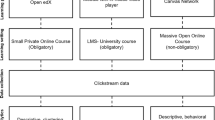Abstract
This case study chapter relates the experience of develo**, evaluating, and iterating a media-rich asynchronous online course in light of increasingly sophisticated data-driven measures of course quality. The case will begin by introducing two guiding analytics frameworks: depth of use (DOU) and video analytics housed in the video content management system at the university. DOU is a measurement of the extent to which LMS tools and elements to promote learner engagement are incorporated into a course site, and it has shown a statistically significant positive correlation with several indicators of student engagement, as well as with mean final student grade in a given course (Hassan et al., Depth of use: An empirical framework to help faculty gauge the relative impact of learning management systems tools. Proceedings of the 2020 ACM Conference on Innovation and Technology in Computer Science Education. https://doi.org/10.1145/2543882.2543885, 2020). Video analytics are used to determine student viewing patterns and glean insights into how the instructional videos could be improved. Additionally, the case will explore the successes and challenges of designing an undergraduate computer science course to meet university priorities. This case will have implications for a wide variety of readers, including but not limited to administrators, professors, and instructional designers.
Similar content being viewed by others
References
6th Annual LMS Data Update. (2018, October 6). Retrieved from https://edutechnica.com/2018/10/06/6th-annual-lms-data-update/
Adeyinka, T. (2011). Reliability and factor analysis of a blackboard course management system success: A scale development and validation in an educational context. Journal of Information Technology Education: Research, 10, 55–80.
Adeyinka, T., & Mutula, S. (2010). A proposed model for evaluating the success of WebCT course content management system. Computers in Human Behavior, 26(6), 1795–1805.
Beck, D., Black, E., Dawson, K., DiPietro, M., & **ks, S. (2007). The other side of the LMS: Considering implementation and use in the adoption of an LMS in online and blended learning environments. Tech Trends, 51(2), 35–39.
Berggren, A., Burgos, D., Fontana, J. M., Hinkelman, D., Hung, V., Hursh, A., & Tielemans, G. (2005). Practical and pedagogical issues for teacher adoption of IMS learning design standards in Moodle LMS. Journal of Interactive Media in Education, 2005(1).
Coates, H., James, R., & Baldwin, G. (2005). A critical examination of the effects of learning management systems on university teaching and learning. Tertiary Education and Management, 11, 19–36.
Dick, W., Carey, L., & Carey, J. O. (2015). The systematic design of instruction. New York, NY: Pearson.
Guzdial, M. (2015). Learner-centered design of computing education: Research on computing for everyone. Synthesis Lectures on Human-Centered Informatics, 8(6), 1–165. https://doi.org/10.2200/S00684ED1V01Y201511HCI033
Hassan, T., Edmison, B., Cox, L., Louvet, M., Williams, D., & McCrickard, D. S. (2020). Depth of use: An empirical framework to help faculty gauge the relative impact of learning management systems tools. In Proceedings of the 2020 ACM Conference on Innovation and Technology in Computer Science Education. https://doi.org/10.1145/3341525.3387375
Kowch, E. G. (2005). Do we plan the journey or read the compass? An argument for preparing educational technologists to lead organisational change. British Journal of Educational Technology, 36, 1067–1070. https://doi.org/10.1111/j.1467-8535.2005.00577.x
Leitner, P., Khalil, M., & Ebner, M. (2017). Learning analytics in higher education: A literature review. In A. Peña-Ayala (Ed.), Learning analytics: Fundaments, applications, and trends: A view of the current state of the art to enhance e-learning (pp. 1–23). Cham, Switzerland: Springer International Publishing.
McGill, T. J., & Klobas, J. E. (2009). A task–technology fit view of learning management system impact. Computers & Education, 52(2), 496–508.
Mwalumbwe, I., & Mtebe, J. S. (2017). Using learning analytics to predict students’ performance in moodle learning management system: A case of Mbeya University of Science and Technology. The Electronic Journal of Information Systems in Develo** Countries, 79(1), 1–13. https://doi.org/10.1002/j.1681-4835.2017.tb00577
Ozkan, S., & Koseler, R. (2009). Multi-dimensional students’ evaluation of e-learning systems in the higher education context: An empirical investigation. Computers & Education, 53(4), 1285–1296.
Resier, R. A., & Dempsey, J. V. (2007). Trends and issues in instructional design and technology (2nd ed.). New York, NY: Pearson.
Samarawickrema, G., & Stacey, E. (2007). Adopting Web-Based Learning and Teaching: A case study in higher education. Distance education, 28(3), 313–333.
Sanders, K., Ahmadzadeh, M., Clear, T., Edwards, S. H., Goldweber, M., Johnson, C., … Spacco, J. (2013). The Canterbury QuestionBank: Building a repository of multiple-choice CS1 and CS2 questions. In Proceedings of the ITiCSE working group reports conference on Innovation and technology in computer science education-working group reports (pp. 33–52). New York, NY: Association for Computing Machinery. https://doi.org/10.1145/2543882.2543885
West, R. E., Waddoups, G., & Graham, C. R. (2007). Understanding the experiences of instructors as they adopt a course management system. Educational Technology Research and Development, 55(1), 1–26.
Wilcox, D., Thall, J., & Griffin, O. (2016). One canvas, two audiences: How faculty and students use a newly adopted learning management system. In Society for Information Technology & Teacher Education International Conference (pp. 1163–1168). Association for the Advancement of Computing in Education (AACE).
Author information
Authors and Affiliations
Corresponding authors
Editor information
Editors and Affiliations
Section Editor information
Rights and permissions
Copyright information
© 2022 Springer Nature Switzerland AG
About this entry
Cite this entry
Williams, D. et al. (2022). Data-Informed Learning Design in a Computer Science Course. In: Spector, M.J., Lockee, B.B., Childress, M.D. (eds) Learning, Design, and Technology. Springer, Cham. https://doi.org/10.1007/978-3-319-17727-4_176-1
Download citation
DOI: https://doi.org/10.1007/978-3-319-17727-4_176-1
Received:
Accepted:
Published:
Publisher Name: Springer, Cham
Print ISBN: 978-3-319-17727-4
Online ISBN: 978-3-319-17727-4
eBook Packages: Springer Reference EducationReference Module Humanities and Social SciencesReference Module Education




